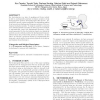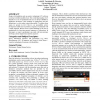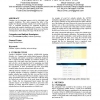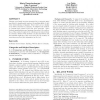ASSETS
2015
ACM
8 years 7 months ago
2015
ACM
The HandSight project investigates how wearable micro-cameras can be used to augment a blind or visually impaired user’s sense of touch with computer vision. Our goal is to supp...
ASSETS
2015
ACM
8 years 7 months ago
2015
ACM
Non-visual text-entry for people with visual impairments has focused mostly on the comparison of input techniques reporting on performance measures, such as accuracy and speed. Wh...
ASSETS
2015
ACM
8 years 7 months ago
2015
ACM
An electrolarynx is a type of speaking aid device which is able to mechanically generate excitation sounds to help laryngectomees produce electrolaryngeal (EL) speech. Although EL...
ASSETS
2015
ACM
8 years 7 months ago
2015
ACM
People with disabilities rely on assistive technology (AT) software to interact with their mobile device. The overall functionality of AT depends on a set of requirements that are...
ASSETS
2015
ACM
8 years 7 months ago
2015
ACM
People who are blind or visually impaired face difficulties using a growing array of everyday appliances because they are equipped with inaccessible electronic displays. We report...
ASSETS
2015
ACM
8 years 7 months ago
2015
ACM
In this work, we present a platform designed for children with Autism Spectrum Disorder to develop language and generalization skills, in response to the lack of applications tail...
ASSETS
2015
ACM
8 years 7 months ago
2015
ACM
Calendars can be important memory aids for individuals with cognitive disabilities. This study compared the effect of the popular two-dimensional table calendar view and the simpl...
ASSETS
2015
ACM
8 years 7 months ago
2015
ACM
Playing error-based exercises presented in a computer game was found to significantly improve the spelling skills of chil dren with dyslexia in Spanish. Since there are no simi...
ASSETS
2015
ACM
2015
ACM
Faster Text-to-Speeches: Enhancing Blind People's Information Scanning with Faster Concurrent Speech
8 years 7 months ago
Blind people rely mostly on the auditory feedback of screen readers to consume digital information. Still, how fast can information be processed remains a major problem. The use o...
ASSETS
2015
ACM
8 years 7 months ago
2015
ACM
Recent contributions proposed sonification techniques to al low people with visual impairment or blindness to extract information from images on touchscreen devices. In this co...




